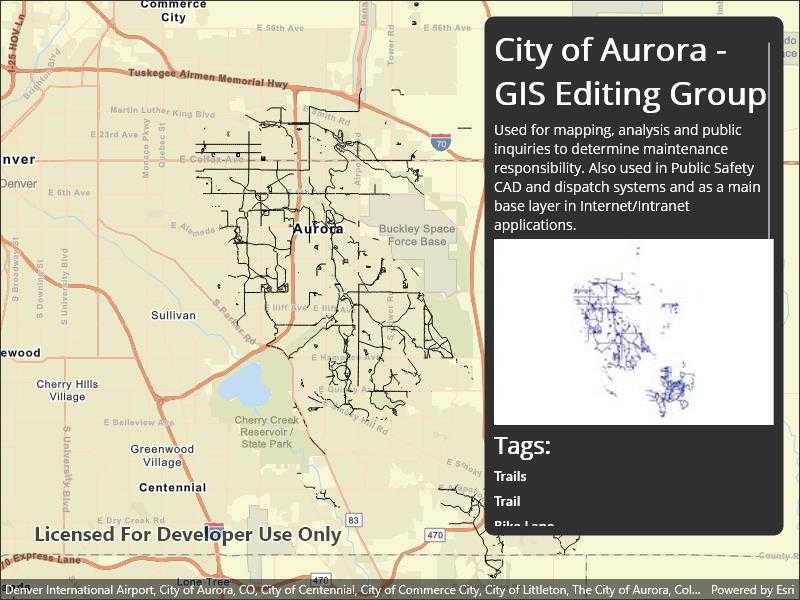Read a shapefile and display its metadata.

Use case
You can display information about the shapefile your user is viewing, like tags, credits, and summary.
How to use the sample
The shapefile's metadata will be displayed when you open the sample.
How it works
- Call
ShapefileFeatureTable.OpenAsync("path_to_shapefile")to create theShapefileFeatureTable. - Get the
ShapefileInfofrom the feature table'sInfoproperty. - Get the image from
fileInfo.Thumbnailand display it. - Display the
Summary,Credits, andTagsproperties from the shapefile info.
Relevant API
- ShapefileFeatureTable
- ShapefileFeatureTable.Info
- ShapefileFeatureTable.OpenAsync
- ShapefileInfo
- ShapefileInfo.Credits
- ShapefileInfo.Summary
- ShapefileInfo.Tags
- ShapefileInfo.Thumbnail
Offline data
Aurora Colorado Shapefiles is available as an item hosted on ArcGIS Online].
About the data
This sample uses a shapefile showing bike trails in Aurora, CO. The Aurora Colorado Shapefiles are available as an item on ArcGIS Online.
Tags
credits, description, metadata, package, shape file, shapefile, summary, symbology, tags, visualization
Sample Code
// Copyright 2022 Esri.
//
// Licensed under the Apache License, Version 2.0 (the "License"); you may not use this file except in compliance with the License.
// You may obtain a copy of the License at: http://www.apache.org/licenses/LICENSE-2.0
//
// Unless required by applicable law or agreed to in writing, software distributed under the License is distributed on an
// "AS IS" BASIS, WITHOUT WARRANTIES OR CONDITIONS OF ANY KIND, either express or implied. See the License for the specific
// language governing permissions and limitations under the License.
using ArcGIS.Samples.Managers;
using Esri.ArcGISRuntime.Data;
using Esri.ArcGISRuntime.Mapping;
namespace ArcGIS.Samples.ReadShapefileMetadata
{
[ArcGIS.Samples.Shared.Attributes.Sample(
name: "Read shapefile metadata",
category: "Data",
description: "Read a shapefile and display its metadata.",
instructions: "The shapefile's metadata will be displayed when you open the sample.",
tags: new[] { "credits", "description", "metadata", "package", "shape file", "shapefile", "summary", "symbology", "tags", "visualization" })]
[ArcGIS.Samples.Shared.Attributes.OfflineData("d98b3e5293834c5f852f13c569930caa")]
public partial class ReadShapefileMetadata : ContentPage
{
public ReadShapefileMetadata()
{
InitializeComponent();
// Open a shapefile stored locally and add it to the map as a feature layer.
_ = Initialize();
}
private async Task Initialize()
{
// Create a new map to display in the map view with a streets basemap.
var streetMap = new Map(BasemapStyle.ArcGISStreets);
// Get the path to the downloaded shapefile.
string filepath = GetShapefilePath();
try
{
// Open the shapefile.
ShapefileFeatureTable myShapefile = await ShapefileFeatureTable.OpenAsync(filepath);
// Read metadata about the shapefile and display it in the UI.
ShapefileInfo fileInfo = myShapefile.Info;
InfoList.BindingContext = fileInfo;
// Read the thumbnail image data into a byte array.
Stream imageStream = await fileInfo.Thumbnail.GetEncodedBufferAsync();
byte[] imageData = new byte[imageStream.Length];
imageStream.Read(imageData, 0, imageData.Length);
// Create a new image source from the thumbnail data.
ImageSource streamImageSource = ImageSource.FromStream(() => new MemoryStream(imageData));
// Create a new image to display the thumbnail.
var image = new Image()
{
Source = streamImageSource,
Margin = new Thickness(10)
};
// Show the thumbnail image in a UI control.
ShapefileThumbnailImage.Source = image.Source;
// Create a feature layer to display the shapefile.
var newFeatureLayer = new FeatureLayer(myShapefile);
await newFeatureLayer.LoadAsync();
// Zoom the map to the extent of the shapefile.
MyMapView.SpatialReferenceChanged += async (s, e) =>
{
await MyMapView.SetViewpointGeometryAsync(newFeatureLayer.FullExtent);
};
// Add the feature layer to the map.
streetMap.OperationalLayers.Add(newFeatureLayer);
// Show the map in the MapView.
MyMapView.Map = streetMap;
}
catch (Exception e)
{
await Application.Current.MainPage.DisplayAlert("Error", e.ToString(), "OK");
}
}
private static string GetShapefilePath()
{
return DataManager.GetDataFolder("d98b3e5293834c5f852f13c569930caa", "TrailBikeNetwork.shp");
}
}
}